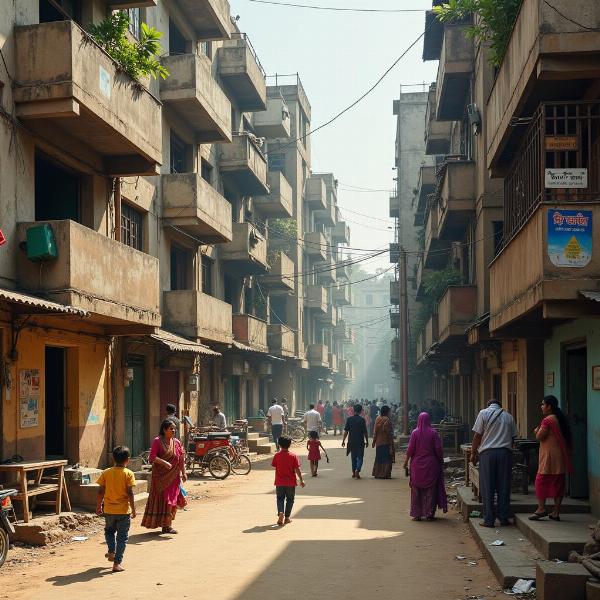Understanding the meaning of “tenements” in Hindi can be tricky, as it doesn’t have a single, direct equivalent. The English word carries connotations of multi-family dwellings, often associated with lower-income housing. This article explores the nuances of “tenements” and its various Hindi translations, considering cultural context and practical usage. We will delve into related terms, common questions, and relevant examples to provide a clear understanding of this complex concept.
Exploring the Hindi Translations of “Tenements”
“Tenements” can be translated into Hindi in several ways, each with its own subtle implications. Some common translations include:
- बहुमंजिला इमारत (Bahumanzila Imarat): This literally translates to “multi-story building” and is a general term. It lacks the specific connotation of lower-income housing often associated with “tenements.”
- किराये के मकान (Kiraye ke Makaan): Meaning “rental houses,” this translation emphasizes the rented nature of tenements, but again, doesn’t necessarily imply lower-income housing.
- झुग्गी बस्ती (Jhuggi Basti): This term refers to slums or shantytowns, and is often used to describe informal settlements with poor living conditions. While not a direct translation, it might be used in contexts where “tenements” refers to dilapidated, overcrowded housing.
- गली मोहल्ले (Gali Mohalle): This phrase refers to narrow lanes and neighborhoods, often associated with densely populated areas where tenements might be found. However, it’s not a direct translation of “tenements” itself.
Choosing the Right Hindi Translation for “Tenements”
The best translation for “tenements” in Hindi depends on the specific context. If you are referring to multi-family dwellings in general, “बहुमंजिला इमारत (Bahumanzila Imarat)” or “किराये के मकान (Kiraye ke Makaan)” might suffice. However, if you want to emphasize the lower-income or dilapidated aspect, “झुग्गी बस्ती (Jhuggi Basti)” might be more appropriate, though it carries a stronger negative connotation. Understanding the nuances of each term is crucial for accurate and sensitive communication.
Understanding the Social Context of Tenements in India
In India, the term “tenements” often evokes images of crowded urban areas, particularly in older cities. These buildings, often characterized by shared facilities and limited space, represent a specific socio-economic reality. While not all tenements are necessarily slums, they often house lower-income families and face challenges related to infrastructure and living conditions.
 Life in an Indian Tenement
Life in an Indian Tenement
Legal and Regulatory Aspects of Tenements
The legal framework surrounding tenements in India is complex and varies by region. Regulations related to building codes, rent control, and tenant rights are crucial for understanding the legal landscape of these dwellings.
What are the challenges faced by tenement residents in India?
Tenement residents in India often face challenges related to overcrowding, inadequate sanitation, limited access to clean water, and lack of proper ventilation. These issues can impact their health, safety, and overall quality of life.
How do tenements impact urban planning and development?
The presence of tenements significantly influences urban planning and development in India. Addressing the challenges related to housing affordability, infrastructure development, and social equity are crucial for creating sustainable urban environments.
Conclusion
Understanding the meaning of “tenements” in Hindi requires more than just a direct translation. It involves grasping the social, economic, and cultural context surrounding these dwellings. This article has explored the various translations and their nuances, providing a comprehensive understanding of “tenements” in the Indian context.
FAQ
-
What is the most common Hindi word for “tenement”? While there isn’t a single perfect equivalent, “बहुमंजिला इमारत (Bahumanzila Imarat)” is a general term often used.
-
Are all tenements in India slums? No, not all tenements are slums. While some tenements may be in poor condition, others are simply multi-family dwellings.
-
What are the legal implications of owning a tenement in India? The legal implications vary by region and depend on factors like rent control laws and building codes.
-
Are there any government initiatives to improve tenement living conditions? Yes, various government programs and initiatives aim to improve housing and infrastructure in tenement areas.
-
How can I find more information about tenement housing in India? Resources like government websites, academic research, and NGOs working in this area can provide further information.
Meaning-Hindi.in is your trusted partner for accurate and culturally sensitive Hindi translation services. We specialize in a wide range of translation services, including business and commercial documents, legal and certified documents, technical manuals, website localization, and academic papers. Our team of expert Hindi linguists ensures precise and nuanced translations that respect cultural context. For all your Hindi translation needs, contact us at [email protected] or call us at +91 11-4502-7584. Meaning-Hindi.in is your one-stop solution for professional Hindi translation services.